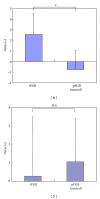Changes in Joint Gap Balances between Intra- and Postoperation in Total Knee Arthroplasty
- PMID: 24669320
- PMCID: PMC3941955
- DOI: 10.1155/2014/790806
Changes in Joint Gap Balances between Intra- and Postoperation in Total Knee Arthroplasty
Abstract
Achieving correct soft tissue balance and preparing equal and rectangular extension and flexion joint gaps are crucial goals of TKA. Intraoperative gap balances would change postoperatively; however, changes in joint gap balances between pre- and postoperation remain unclear. To explore these changes associated with TKA, we prospectively investigated 21 posterior cruciate ligament retaining TKAs for varus knees. Intraoperative extension gap balance (iEGB) was 2.6 ± 2.0° varus versus postoperative extension gap balance (pEGB) of 0.77 ± 1.8° valgus (P < 0.01), while no significant difference between intraoperative flexion gap balance (iFGB) and postoperative flexion gap balance (pFGB) was observed. We also explored correlations between intraoperative and postoperative gap balances but found no significant correlations. These observations indicate that (i) surgeons should avoid excessive release of the medial soft tissue during TKA for varus knees and (ii) intraoperative gap balance may not be necessarily reflected on postoperative gap balance.
Figures



References
-
- Winemaker MJ. Perfect balance in total knee arthroplasty: the elusive compromise. The Journal of Arthroplasty. 2002;17(1):2–10. - PubMed
-
- Insall JN, Ranawat CS, Scott WN, Walker P. Total condylar knee replacement: preliminary report. Clinical Orthopaedics and Related Research. 1976;(120):149–154. - PubMed
-
- Insall JN, Binazzi R, Soudry M, Mestriner LA. Total knee arthroplasty. Clinical Orthopaedics and Related Research. 1985;(192):13–22. - PubMed
-
- Tanzer M, Smith K, Burnett S. Posterior-stabilized versus cruciate-retaining total knee arthroplasty: balancing the gap. The Journal of Arthroplasty. 2002;17(7):813–819. - PubMed
-
- Whiteside LA, Saeki K, Mihalko WM. Functional medical ligament balancing in total knee arthroplasty. Clinical Orthopaedics and Related Research. 2000;(380):45–57. - PubMed
LinkOut - more resources
Full Text Sources
Other Literature Sources
Miscellaneous

